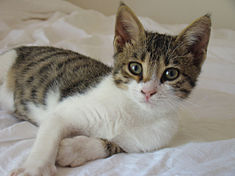Kucing siprus
|
Kucing siprus | |
|---|---|

| |
| Anak kucing bulu pendek siprus betina. | |
| Nama lain | Kucing bulu pendek siprus Kucing bulu panjang siprus |
| Asal | |
| Julukan umum | Kucing sipriot |
| Kucing domestik (Felis catus) | |
Kucing siprus adalah salah satu ras lokal kucing domestik yang diyakini berasal dari Mesir atau Palestina yang kemudian dibawa ke Siprus oleh Santa Helena untuk membersihkan pulau dari ular dan hama. Siprus tidak diakui resmi oleh organisasi pendaftaran kucing.
Sejarah
[sunting | sunting sumber]Menurut penelitian yang dilakukan oleh J.-D. Vigne, et al., siprus adalah kucing tertua yang dapat ditemukan di Siprus. Pada tahun 2004, seorang arkeologi yang bekerja di situs Neolitikum Shillourokambos, menemukan kerangka kucing bersama dengan kerangka manusia dan artefak dekoratif di kuburan suatu makam. Saat diperiksa, kuburan tersebut menunjukkan bahwa ada lubang kecil yang telah sengaja digali, dan tubuh kucing tersebut ditempatkan di dalamnya. Kerangka kucing ini telah mendahului penggambaran budaya kucing di Mesir dengan 4.000 tahun yang lalu ataupun lebih.[1]
Siprus pernah dibawa ke vihara Bizantium yang bernama "St. Nicholas of the Cats" (Yunani: Άγιος Νικόλαος των Γατών), yang didirikan pada abad keempat Masehi. Menurut legenda Bizantium, St Helen mengimpor ratusan kucing dari Mesir atau Palestina pada abad keempat untuk mengendalikan ular berbisa yang penuh di vihara. Vihara tersebut memiliki dua lonceng, satu untuk memanggil kucing untuk makan dan yang lainnya untuk mengirim kucing ke ladang untuk berburu ular. Saat ini, populasi kucing di vihara telah menyusut.[2]
Giorgos Seferis pernah menulis tentang ras siprus dalam puisinya, "The Cats of St Nicholas" yang diterjemahkan oleh Edmund Keely dan Philip Sherrard pada tahun 1995.[3]
Karakteristik
[sunting | sunting sumber]Siprus adalah kerabat dekat dari ras siprus berbulu panjang. Banyak ras kucing siprus ditemukan di kota-kota siprus, termasuk Limassol, Nicosia, Paphos, dan Larnaca. Dalam banyak kasus, sebagian besar ras siprus telah menjadi liar.
Referensi
[sunting | sunting sumber]- ^ J.-D. Vigne, J. Guilaine, K. Debue, L. Haye, and P. Gérard (April 9, 2004). "Early Taming of the Cat in Cyprus". Science. 304. hlm. 259.
- ^ Marc Dubin (2009). The Rough Guide To Cyprus. Rough Guide. hlm. 135–136.
- ^ George Seferis, Collected Poems. Princeton University. 1995.
Text is available under the CC BY-SA 4.0 license; additional terms may apply.
Images, videos and audio are available under their respective licenses.
